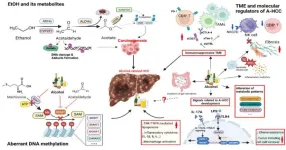(Press-News.org) Embargoed for release until 9:00 a.m. ET on Friday 19 April 2024
Embargoed Content from the Annals of Internal Medicine Breaking News Scientific Plenary at Internal Medicine 2024
Annals of Internal Medicine Tip Sheet
@Annalsofim
Below please find summaries of new articles that will be published in the next issue of Annals of Internal Medicine. The summaries are not intended to substitute for the full articles as a source of information. This information is under strict embargo and by taking it into possession, media representatives are committing to the terms of the embargo not only on their own behalf, but also on behalf of the organization they represent.
----------------------------
1. American College of Physicians issues clinical recommendations for newer pharmacological treatments of adults with Type 2 diabetes
Reviews evidence of newer medications, recommends adding to metformin
Abstract: https://www.acpjournals.org/doi/10.7326/M23-2788
Editorial: https://www.acpjournals.org/doi/10.7326/M24-0861
Review: https://www.acpjournals.org/doi/10.7326/M23-1490
Review: https://www.acpjournals.org/doi/10.7326/M23-1492
URL goes live when the embargo lifts
A new guideline from the American College of Physicians (ACP) offers clinical recommendations for the use of newer pharmacological treatments of adults with Type 2 diabetes. This is an update of ACP's 2017 guideline and is based on the best available evidence for effectiveness, comparative benefits and harms, consideration of patients’ values and preferences, and costs. Newer Pharmacological Treatments in Adults with Type 2 Diabetes: A Clinical Guideline from the American College of Physicians is published in Annals of Internal Medicine.
In the updated clinical guideline, ACP recommends adding a sodium-glucose cotransporter-2 (SGLT-2) inhibitor or glucagon-like peptide-1 (GLP-1) agonist to metformin and lifestyle interventions in patients with Type 2 diabetes and inadequate glycemic control. Use SGLT-2 inhibitor to reduce the risk of all-cause mortality, major adverse cardiovascular events, progression of chronic kidney disease, and hospitalization due to congestive heart failure or use GLP-1 agonist to reduce the risk of all-cause mortality, major adverse cardiovascular events, and stroke. ACP, however, recommends against adding a dipeptidyl peptidase-4 (DPP-4) inhibitor to metformin and lifestyle modifications in adults with Type 2 diabetes and inadequate glycemic control because high-certainty evidence showed that adding a DPP-4 inhibitor does not reduce morbidity or all-cause mortality.
This clinical guideline is based on systematic reviews of the benefits, harms, and cost-effectiveness of newer pharmacological treatments for Type 2 diabetes. ACP prioritized the following outcomes, which were evaluated using the GRADE (Grading of Recommendations, Assessment, Development and Evaluation) approach: all-cause mortality, major adverse cardiovascular events, myocardial infarction, stroke, hospitalization for congestive heart failure, progression of chronic kidney disease, serious adverse events, and severe hypoglycemia. Weight loss, as measured by percentage of participants who achieved at least 10% total body weight loss, was a prioritized outcome, but data were insufficient for network meta-analysis and not rated with GRADE.
The updated ACP guideline did not look at the effects of treatment for glycemic control, though this is a common treatment goal. It is known that all included treatments can improve glycemic control in adults with Type 2 diabetes. Instead, the guideline focuses on clinical benefit outcomes, such as whether the treatments improve cardiovascular outcomes.
ACP guidelines emphasize shared decision-making, recognizing that each patient's needs and circumstances are unique. ACP encourages physicians to consider individual patient characteristics like age, comorbidities, and personal preferences when discussing a treatment plan for Type 2 diabetes. SGLT-2s and GLP-1s are costly, but lower cost options (like sulfonylureas) were inferior in reducing all-cause mortality and morbidity. There are currently no generic formulations for GLP-1s and SGLT-2.
The author of an accompanying editorial from Duke University Division of General Internal Medicine suggests that cost presents a significant barrier to GLP1 agonists and SGL2T inhibitors. Patients with obesity and diabetes need easier access to these medications, especially given their unmatched effectiveness for glucose control and weight reduction. According to the author, the cost-effectiveness of GLP1 agonists and SGLT2 inhibitors as initial diabetes therapy in the setting of various comorbid conditions warrants careful exploration.
Along with the supporting review articles, the ACP clinical guideline is published with an accompanying visual clinical guideline aimed to efficiently interact with and visualize the data supporting these recommendations.
Media contacts: For an embargoed PDF, please contact Angela Collom at acollom@acponline.org or Addison Dunlap at adunlap@acponline.org. To speak with someone from ACP, please contact Andy Hachadorian at ahachadorian@acponline.org.
----------------------------
2. Newer antibiotics underprescribed for highly resistant infections
Sluggish uptake threatens future development and supply of new antibiotics for patients
Abstract: https://www.acpjournals.org/doi/10.7326/M23-2309
Editorial: https://www.acpjournals.org/doi/10.7326/M24-0192
URL goes live when the embargo lifts
A large retrospective cohort pharmacoepidemiologic study found that despite approval by the U.S. Food and Drug Administration (FDA) for 7 new gram-negative antibiotics between 2014 and 2019, clinicians in U.S. hospitals still treated more than 40 percent of patients battling highly resistant pathogens exclusively with older, generic agents. Furthermore, nearly 80 percent of the time these older agents are already known to be highly toxic or sub-optimally effective. According to the authors, this issue not only affects patient outcomes but threatens future development and supply of new antibiotics. The findings were presented at the breaking news scientific plenary session "New in Annals of Internal Medicine: Hear it First from the Authors" held at the Boston Convention and Exhibition Center during the American College of Physician’s (ACP) Internal Medicine Meeting 2024. The paper also is published in Annals of Internal Medicine.
Researchers from the National Institutes of Health retrospectively studied data from a large administrative database to determine inpatient use patterns of recently approved gram-negative antibiotics, including ceftazidime–avibactam, ceftolozane–tazobactam, meropenem–vaborbactam, plazomicin, eravacycline, imipenem–relebactam–cilastatin, and cefiderocol. The researchers found that ceftolozane–tazobactam and ceftazidime–avibactam, the 2 first “next-generation” b-lactam/b-lactamase inhibitor antibiotics approved by the FDA, had the largest increase in use between 2016 and 2019. However, utilization of other next-generation antibiotics, including meropenem–vaborbactam, eravacycline, imipenem–cilastatin–relebactam, and cefiderocol was much lower, with no documented use of plazomicin (the manufacturer of which latter filed for bankruptcy).
Researchers also sought to identify factors associated with preferential use of newer antibiotics over traditional generic agents. Clinicians seemed to prefer newer agents to treat patients with difficult-to-treat bloodstream infections and those with a high comorbidity burden. At the hospital level, some important factors associated with new versus traditional agent use were identified. For example, a third of study hospitals never used new antibiotics and those tended to be small hospitals in rural areas or in urban areas with low prevalence of resistance. New antibiotics were also about 6 times more expensive than older agents, which could disincentivize prescribing given the way hospitals are reimbursed for care in the US. A lack of hospital access to a new agent did not seem to be a major factor for underutilization but hospitals that reported antibiotic susceptibility testing against new antibiotics tended to prescribe them more. According to the study authors, these findings underscore the need to prioritize unmet patient needs in future economic incentives for the failing antibiotic industry (such as the recent PASTEUR bill).
The authors of an accompanying editorial from Tufts University School of Medicine say that with antimicrobial resistance estimated to cause 1.2 million deaths globally per year, it's important to ensure that new antibiotics are not only being developed but also effectively used. Getting an antibiotic to market takes 10 to 15 years and can cost up to a $1 billion. The editorialists commend the study authors for investigating what happens after antibiotics are approved. They suggest that continued efforts to raise awareness, innovation in pathogen-specific trials, regularly updated guidance, innovative patient-centered end points, and rapid susceptibility testing will be key to appropriate and optimal use of these new antibiotics.
Media contacts: For an embargoed PDF, please contact Angela Collom at acollom@acponline.org. To speak with the corresponding author, Sameer S. Kadri, MD, please contact Yvonne Hylton at yvonne.hylton@nih.gov.
----------------------------
3. RCT finds calories may be more important than meal timing when it comes to weight loss
Abstract: https://www.acpjournals.org/doi/10.7326/M23-3132
Editorial: https://www.acpjournals.org/doi/10.7326/M24-0695
URL goes live when the embargo lifts
A randomized controlled trial comprised of adults with obesity and prediabetes found that both time-restricted eating and a usual eating pattern resulted in weight loss when calories were held constant in both groups. It did not seem to matter whether participants consumed most of their calories early in the day or in the evening, suggesting that overall calories may be more important than meal timing when it comes to weight loss. The findings were presented at the inaugural scientific plenary session "New in Annals of Internal Medicine: Hear it First from the Authors" held at the Boston Convention and Exhibition Center during the American College of Physician’s (ACP) Internal Medicine Meeting 2024. The paper also is published in Annals of Internal Medicine.
Time-restricted eating (TRE) is a diet approach where patients limit their eating to a window of time during the day and then fast for the remaining hours. During the eating window, patients are not required to count calories or monitor food intake and during the fasting window, patients are limited to water and calorie-free beverages. Evidence shows that when adults with obesity limit their eating window to 4 to 10 hours, they naturally reduce caloric intake by approximately 200-550 calories per day and lose weight over 2-12 months. Whether TRE induces weight loss independent of reductions in calorie intake, as seen in rodent studies, is unknown.
Researchers from Johns Hopkins University randomly assigned 41 adults with obesity and prediabetes to either TRE with a 10-hour eating window or a regular eating pattern for 12 weeks (about 3 months) to compare weight loss and other measures of metabolic health. At the beginning of the study, the researchers assessed participants’ history and activity level to estimate baseline caloric needs, and participants ate the same number of calories daily throughout the study. Participants in both arms received prepared meals with identical macronutrient and micronutrient compositions and instructions on when to consume the meals. The time restricted eating group was instructed to eat only between the hours of 8am to 6pm and consumed most of their calories before 1pm each day. The usual eating pattern group ate between 8am and midnight and consumed most of their calories after 5pm each day. After 12 weeks, both groups lost about the same amount of weight and there were no real differences in fasting glucose, waist circumference, blood pressure, or lipid levels. According to the authors, these findings suggest that if or when TRE interventions induce weight loss, it is likely in part due to a reduction in calories, and, therefore, clinicians can counsel patients that TRE may help them lose weight by decreasing their caloric intake.
According to the authors of an accompanying editorial from the University of Illinois Chicago, these results have important clinical implications. While TRE was not found to be more effective for weight loss, it may be easier for patients to follow because it allows them to continue consuming familiar foods. This simplified approach to treating obesity could help patients who don’t do well counting calories.
Media contacts: For an embargoed PDF, please contact Angela Collom at acollom@acponline.org. To speak with the corresponding author, Nisa Maruthur, MD, MHS, please contact Michel Morris at melben1@jhmi.edu.
----------------------------
END
ACP issues clinical recommendations for newer diabetes treatments
2024-04-19
ELSE PRESS RELEASES FROM THIS DATE:
New insights into the connections between alcohol consumption and aggressive liver cancer
2024-04-19
While heavy drinking is a well-established risk factor for liver cancer, the specific mechanisms by which alcohol contributes to A-HCC remain unclear.
This insightful review, published in Hepatology, provides a comprehensive summary of the pathogenesis, heterogeneity, preclinical approaches, epigenetic and genetic profiles of A-HCC. Compared to other types of liver cancer, A-HCC is often diagnosed at a later stage, when the disease is more advanced. This is partly due to a lack of readily available screening tools for individuals with alcohol-related liver disease (ALD).
"A-HCC is a serious public health concern," ...
Unraveling water mysteries beyond Earth
2024-04-19
The first clue for finding life on other planets is finding liquid water. The moons of Saturn and Jupiter like Enceladus, Ganymede, Europa, and Callisto are suspected of holding oceans of liquid water beneath icy crusts. Similarly, some exoplanets beyond our solar system likely host liquid water, crucial for habitability. But detecting water, when we can’t physically access these celestial bodies, poses challenges. Ice-penetrating radar, a geophysical tool, has proven capable of detecting liquid water ...
Signs of multiple sclerosis show up in blood years before symptoms
2024-04-19
In a discovery that could hasten treatment for patients with multiple sclerosis (MS), UC San Francisco scientists have discovered a harbinger in the blood of some people who later went on to develop the disease.
In about 1 in 10 cases of MS, the body begins producing a distinctive set of antibodies against its own proteins years before symptoms emerge. These autoantibodies appear to bind to both human cells and common pathogens, possibly explaining the immune attacks on the brain and spinal cord that are the hallmark of MS.
The findings were published in Nature Medicine on ...
Ghost particle on the scales
2024-04-19
In the 1930s, it turned out that neither the energy nor the momentum balance is correct in the radioactive beta decay of an atomic nucleus. This led to the postulate of "ghost particles" that "secretly" carry away energy and momentum. In 1956, experimental proof of such neutrinos was finally obtained. The challenge: neutrinos only interact with other particles of matter via the weak interaction that is also underlying the beta decay of an atomic nucleus. For this reason, hundreds of trillions of neutrinos from the cosmos, especially the sun, can pass through our bodies every second without causing any damage. Extremely ...
Light show in living cells
2024-04-19
Observing proteins precisely within cells is extremely important for many branches of research but has been a significant technical challenge - especially in living cells, as the required fluorescent labelling had to be individually attached to each protein. The research group led by Stefan Kubicek at CeMM has now overcome this hurdle: With a method called "vpCells," it is possible to label many proteins simultaneously, using five different fluorescent colours. This automated high-throughput approach, aided by AI-assisted image recognition, opens up entirely new applications in various disciplines, from fundamental cell biology to drug discovery. The study ...
Climate change will increase value of residential rooftop solar panels across US, study shows
2024-04-19
Graphic
Climate change will increase the future value of residential rooftop solar panels across the United States by up to 19% by the end of the century, according to a new University of Michigan-led study.
The study defines the value of solar, or VOS, as household-level financial benefits from electricity bill savings plus revenues from selling excess electricity to the grid—minus the initial installation costs.
For many U.S. households, increased earnings from residential rooftop ...
Could the liver hold the key to better cancer treatments?
2024-04-19
PHILADELPHIA – Liver inflammation, a common side-effect of cancers elsewhere in the body, has long been associated with worse cancer outcomes and more recently associated with poor response to immunotherapy. Now, a team led by researchers from the Abramson Cancer Center and Perelman School of Medicine at the University of Pennsylvania has found a big reason why.
In their study, published today in Nature Immunology, the researchers discovered that cancer-induced liver inflammation causes liver cells to secrete proteins called serum amyloid A (SAA) proteins, which circulate through the body and hinder the ability of T cells—major anticancer weapons of the immune system—to ...
Warming of Antarctic deep-sea waters contribute to sea level rise in North Atlantic, study finds
2024-04-19
Analysis of mooring observations and hydrographic data suggest the Atlantic Meridional Overturning Circulation deep water limb in the North Atlantic has weakened. Two decades of continual observations provide a greater understanding of the Earth’s climate regulating system.
A new study published in the journal Nature Geoscience led by scientists at University of Miami Rosenstiel School of Marine, Atmospheric, and Earth Science, and the National Oceanic and Atmospheric Administration’s Atlantic ...
Study opens new avenue for immunotherapy drug development
2024-04-19
HOUSTON ― In a new study published today in Nature Biomedical Engineering, researchers at The University of Texas MD Anderson Cancer Center have designed a new method for developing immunotherapy drugs using engineered peptides to elicit a natural immune response inside the body.
In preclinical models of locally advanced and metastatic breast cancer, this method improved tumor control and prolonged survival, both as a monotherapy and in combination with immune checkpoint inhibitors.
“Amino acids are the building blocks of life and, when a few of them are linked together, they create a peptide. ...
Baby sharks prefer being closer to shore, show scientists
2024-04-19
Remember #BabyShark? And no, this was not the very catchy song for kids that took the internet by storm. Earlier this year, social media was abuzz with stunning footage of a newborn great white shark, captured by a flying drone.
Now, marine scientists have shown for the first time that juvenile great white sharks select warm and shallow waters to aggregate within one kilometer from the shore. These results, published in Frontiers in Marine Science, are important for conservation of great white sharks – especially as ocean temperatures increase due ...





